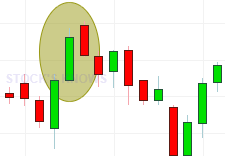Hey friends, welcome to Stock’s Knows. This is the 4th article of technical analysis. In this article, we will learn about some candlestick patterns and their interpretation. Candlestick charts are most useful charts because different types of candlestick patterns have their different interpretation which is very helpful to understand the market.
A candlestick pattern which has the only body but no shadow or small shadow is known as marubozu. A rarely found marubozu candlestick pattern is of both types bullish and bearish. For bullish marubozu, always open equals Low and Close always equals high, in bearish Marubozu open equals High and Close equals Low. Marubozu type candlestick pattern can be both continuation and reversal pattern.
Marubozu as Bullish continuation pattern:
Marubozu as Bullish reversal pattern:
If you find Bullish marubozu after the downtrend, it is the indication of a reversal of trend and uptrend may be coming.
Marubozu as Bearish Continuation pattern:
If you find Bearish marubozu in the downtrend it is the indication of the continuation of that downtrend.
Marubozu as bearish reversal pattern:
If you find bearish marubozu after the uptrend, it is the indication of trend reversal may be coming.

2)Spinning top :
In spinning top candlestick pattern, a body is very small as compare to shadows. Generally, shadows are more than double size of the body. This looks like a spinning top toy, so it named as spinning top candle. It is the sign of indecision and it generally forms at the end of an uptrend or a downtrend. After spinning top candlestick pattern one need to wait for next candle, which will indicate the situation.
Spinning Top candlestick pattern can indicate both bullish and bearish reversal.
3)Doji:
Doji patterns have very small or nobody and long shadows, there are four types of doji patterns:
a)Gravestone doji,
b)Dragonfly doji,
c) Doji
d)Long-legged Doji
a)Gravestone Doji generally forms after an uptrend and it is the indication of the end of an uptrend or reversal of an uptrend and downtrend might start.
b)Dragonfly doji,
c) Doji
d)Long-legged Doji
a)Gravestone Doji generally forms after an uptrend and it is the indication of the end of an uptrend or reversal of an uptrend and downtrend might start.
b)Dragonfly doji generally forms after a downtrend and it is the indication of an end of downtrend or reversal of trend and uptrend might start.
c)Doji forms both after the uptrend or after the downtrend. If it forms after the uptrend, it indicates the bearish trend reversal. If it forms after the downtrend, it indicates the bullish trend reversal.
d)Long-legged doji forms after both of trends. If it forms after uptrend it indicates the bearish trend reversal ( or indecision) and if it forms after downtrend it indicates bullish trend reversal (or indecision).
3)Hammer and Inverted Hammer pattern:
i)Hammer candlestick pattern looks like the hammer, it has the small body, small upper shadow, and longer lower shadow. There is no bullish or bearish hammer, hammer generally forms after significant downtrend near the bottom of the downtrend. whether it has the bullish body or bearish body it indicates that bottom may be hammered out and uptrend might start. Price will go up from here.
ii)Inverted hammer candlestick pattern looks like the inverted hammer, it has the small body, small lower shadow, and long upper shadow. Generally, length of the shadow is more than double of the length of the body. It generally forms after both uptrend and downtrend. If it forms at the bottom, after significant downtrend it indicates that buyers are coming back and sellers are exhausted.
iii)Shooting star:
If inverted hammer form at the top, after significant uptrend it is known as shooting star because it looks like when a star shooting from the sky. If low of shooting star breaks in next candle it clearly indicates of bearish reversal and downtrend might come because of sellers are back in the game.
This was the part 1 of candlestick patterns, in 2nd part will understand candlestick patterns formed by more than one candle. If you find helpful above information then please Share our article and Subscribe to the newsletter of our blog.





















